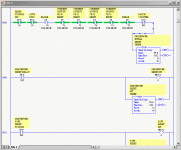glaverty
Member
As some of you may recall from a few of my previous posts I have been working on a project with an SLC5/02 and a 1746-HSCE in sequencer mode. I've been trying to figure out how this thing works for a while now and have come to a problem that I just cannot figure out.
So I thought I would post my problem here and see if you any of you can help me out.
Basically the machine cuts sheets of metal to length and punches some holes in them.
The operator chooses which type of band he wants the machine to run through a panelview 550.
Depending on which Band the operator chooses determines a different N File which gets loaded into the high speed counter file MO:6.0.
The problem that I am having is that after going through all the N files for the different parts it seems as if the sequence is missing a set of punches for all the band types. But I have seen the machine run and it punches all the holes it is supposed to so I must be missing something. The files I am using are right out of the machine so I know they are the correct ones.
A sequence basically looks like this
Slow clutch
Brake, Punch 1, Punch 2
Fast Clutch
Slow Clutch
Brake, Shear
Fast Clutch
Slow Clutch
Brake, Punch 3
Fast Clutch
Slow Clutch
Brake
Once the sequence reaches the point where only the brake is on the high speed counter is reset and the process starts all over again.
A finished part will have two holes punched on each of its ends and one hole somewhere between the other two sets but not centered.
Going through the sequence I see how the first set of two holes is punched and the hole in the middle but I don't see how the second set of two holes gets punched.
I am attaching a Zip file with 3 files. Two of the files are gifs, one shows what a finished part looks like and the other shows the layout of the punches, shear, and encoder on the machine. The third file is an excel spreadsheet which I created which breaks up the N files which get loaded into the high speed counter. I will be writing a second post in order to upload the RSLogix program itself.
I realize this is a lot of information for anyone to go through in order to help me but any help will be EXTREMELY appreciated.
So I thought I would post my problem here and see if you any of you can help me out.
Basically the machine cuts sheets of metal to length and punches some holes in them.
The operator chooses which type of band he wants the machine to run through a panelview 550.
Depending on which Band the operator chooses determines a different N File which gets loaded into the high speed counter file MO:6.0.
The problem that I am having is that after going through all the N files for the different parts it seems as if the sequence is missing a set of punches for all the band types. But I have seen the machine run and it punches all the holes it is supposed to so I must be missing something. The files I am using are right out of the machine so I know they are the correct ones.
A sequence basically looks like this
Slow clutch
Brake, Punch 1, Punch 2
Fast Clutch
Slow Clutch
Brake, Shear
Fast Clutch
Slow Clutch
Brake, Punch 3
Fast Clutch
Slow Clutch
Brake
Once the sequence reaches the point where only the brake is on the high speed counter is reset and the process starts all over again.
A finished part will have two holes punched on each of its ends and one hole somewhere between the other two sets but not centered.
Going through the sequence I see how the first set of two holes is punched and the hole in the middle but I don't see how the second set of two holes gets punched.
I am attaching a Zip file with 3 files. Two of the files are gifs, one shows what a finished part looks like and the other shows the layout of the punches, shear, and encoder on the machine. The third file is an excel spreadsheet which I created which breaks up the N files which get loaded into the high speed counter. I will be writing a second post in order to upload the RSLogix program itself.
I realize this is a lot of information for anyone to go through in order to help me but any help will be EXTREMELY appreciated.




